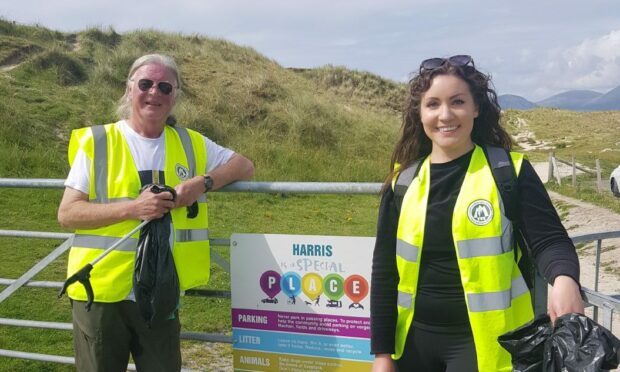Voluntary parking fees may be introduced at some tourism hotspots in the Outer Hebrides to help manage growing visitor numbers.
The idea is being mooted as part of efforts to provide improved facilities for visitors while encouraging responsible behaviour.
In June, Community Land Outer Hebrides (CLOH) appointed two visitor management wardens at tourism hotspots in six community-owned trust locations.
They are promoting and encouraging responsible access, camping and parking in line with the Scottish Outdoor Access Code (SOAC) and Outer Hebrides is a special PLACE (Parking, Litter, Animals, Camping, Engage) campaign.
The wardens are also conducting a visitor survey to get better information on numbers and what facilities are needed.
Positive feedback on voluntary payments
Early findings include support for voluntary parking fees to help communities reinvest in facilities and the environment.
Iain Farrell, one of the wardens, said there has been “almost unanimous” positive feedback about voluntary payments so far in the survey which ends next month.
“My impression is that it could be a useful answer that some of the other trusts might pick up on where appropriate for their particular areas.
“A voluntary donation tends to make more money than a fixed charge.
“People understand things are run by the community trust and the money is re-invested in the facility or in the protection of the environment around the site.”
Parking and camping issues have arisen at a number of island sites due to increasing pressure from visitors.
The North Harris Trust opened the Huisinis Gateway in 2017 to improve visitor management at an increasingly popular area of machair.
It provides toilets and showers as well as a waste disposal point and recycling bins.
There are also parking areas to limit impacts on the machair, and campervan hook-ups to minimise vehicle pressure.
A donations scheme for parking was replaced last year with parking meters which accept contactless card payments.
The income is used on utilities and staff costs, maintenance of the site and local footpaths, funding community projects and to help sustain crofting practices.
Finding ways to self-fund projects
Trust manager Michael Hunter said: “There is a way, we think, for these hotspot areas to be managed. It’s a no brainer for other community land areas.
“We don’t want to discourage visitors, but the charging system has helped pay for staff.
“We cannot rely on funding forever – we have to find our own ways of self-funding what we need.”
CLOH development manager Finlay MacLennan said: “I believe the North Harris Trust have had a positive experience of introducing the voluntary parking charge system.
“It would be worthwhile exploring all avenues that would provide some revenue for investment in developing tourist hotspots.”
Jemma MacVicar, executive manager at Galson Estate Trust, said: “It can be challenging to access funding to improve and maintain infrastructure for visitors.
“Voluntary parking fees would be of benefit to help fund these improvements.
“I think it is also important to communicate what the fees are contributing to when facilities are community-run.”
She said the wardens have also helped disperse visitors to other attractions, rather than being concentrated at hotspot locations.
The main hotspots involved in the survey are Luskentyre, Husinins, Cnip and Riof beaches, the Carloway Broch, Barvas machair and the Butt of Lewis lighthouse.
Earlier this year, a petition was launched to stop tourists blocking access to Luskentyre Cemetery car park. It has been signed by more than 4,000 people.
Survey will help reduce hotspot pressure
Mr Farrell said engagement with the majority of visitors has been positive most of the time.
“Most people at least have some awareness of the code and understand the principles.
“I’ve not had an encounter yet that was less than friendly.
“The survey is a brilliant instrument for engaging with people, not just to strip out data, but also to give them information and advice.”
Mr Maclennan said he hopes the survey will help reduce pressures on communities.
“I think boots on the ground and people interacting with visitors is seen as the best way of making sure that if issues occur they do not reoccur and people are more informed about making the right decisions in future.”
Roddy Mackinnon, Uig Development Trust development officer, said Uig does not suffer from the same pressures as other areas.
“Nevertheless, we have seen a huge increase in visitor numbers in the last 5-10 years with no corresponding improvements in visitor facilities or infrastructure.”
He said some areas have donation boxes with money used to provide items including bins.
“I can definitely see the benefits of donations poles or boxes.”




Conversation